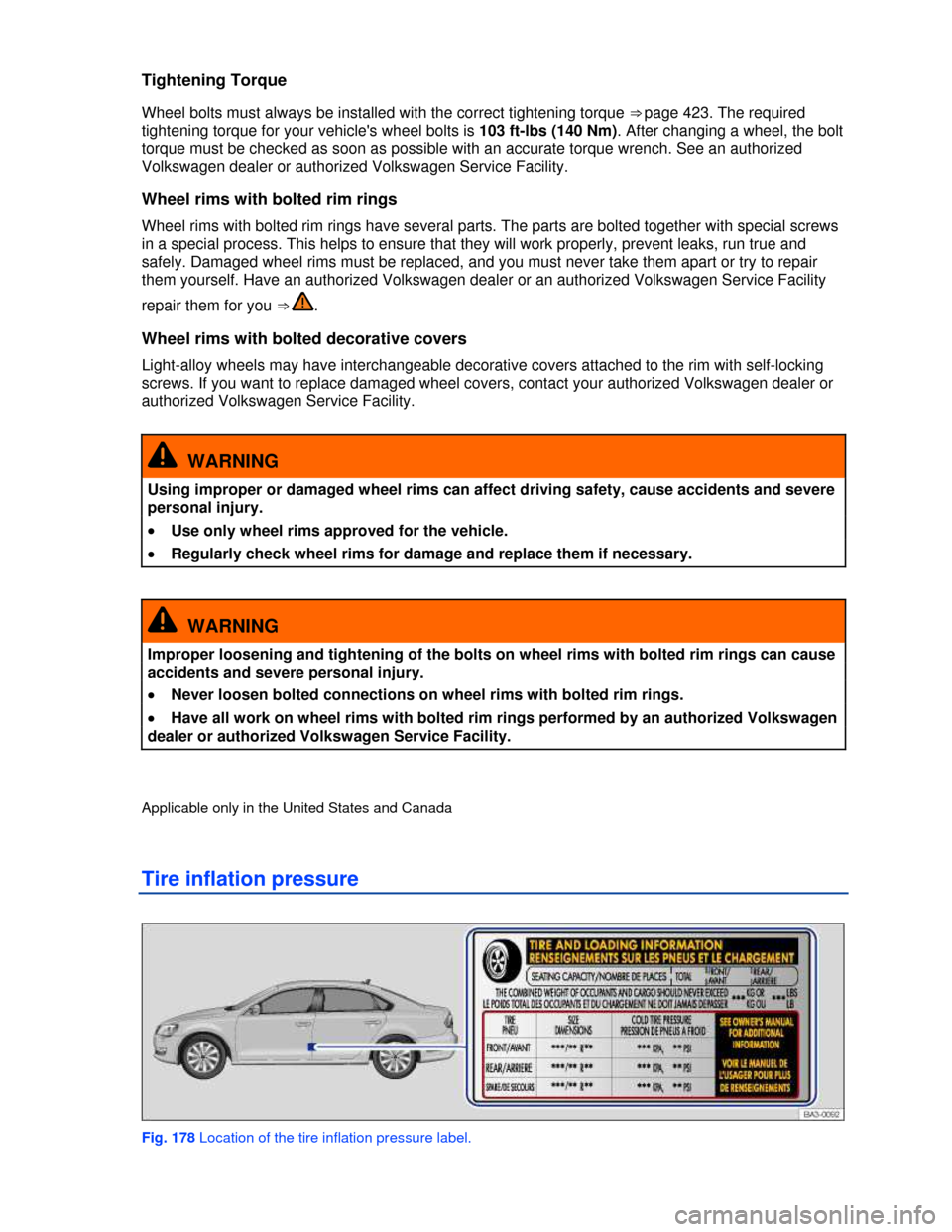2013 VOLKSWAGEN PASSAT run flat
[x] Cancel search: run flatPage 297 of 379

Tightening Torque
Wheel bolts must always be installed with the correct tightening torque ⇒ page 423. The required
tightening torque for your vehicle's wheel bolts is 103 ft-lbs (140 Nm). After changing a wheel, the bolt
torque must be checked as soon as possible with an accurate torque wrench. See an authorized
Volkswagen dealer or authorized Volkswagen Service Facility.
Wheel rims with bolted rim rings
Wheel rims with bolted rim rings have several parts. The parts are bolted together with special screws
in a special process. This helps to ensure that they will work properly, prevent leaks, run true and
safely. Damaged wheel rims must be replaced, and you must never take them apart or try to repair
them yourself. Have an authorized Volkswagen dealer or an authorized Volkswagen Service Facility
repair them for you ⇒ .
Wheel rims with bolted decorative covers
Light-alloy wheels may have interchangeable decorative covers attached to the rim with self-locking
screws. If you want to replace damaged wheel covers, contact your authorized Volkswagen dealer or
authorized Volkswagen Service Facility.
WARNING
Using improper or damaged wheel rims can affect driving safety, cause accidents and severe
personal injury.
�x Use only wheel rims approved for the vehicle.
�x Regularly check wheel rims for damage and replace them if necessary.
WARNING
Improper loosening and tightening of the bolts on wheel rims with bolted rim rings can cause
accidents and severe personal injury.
�x Never loosen bolted connections on wheel rims with bolted rim rings.
�x Have all work on wheel rims with bolted rim rings performed by an authorized Volkswagen
dealer or authorized Volkswagen Service Facility.
Applicable only in the United States and Canada
Tire inflation pressure
Fig. 178 Location of the tire inflation pressure label.
Page 317 of 379

used to replace the flat front tire. Be sure to install the unidirectional tires so that they will run in the
proper direction. Volkswagen recommends installing the snow chains before mounting the wheel to
the vehicle.
WARNING
Using the wrong snow chains or installing snow chains improperly can cause accidents and
severe personal injuries.
�x Always use the proper snow chains.
�x Follow the installation instructions provided by the snow chain manufacturer.
�x Never exceed the permissible speed limit when driving with snow chains.
NOTICE
�x Remove snow chains when roads are free of snow. Otherwise, the chains can damage the
tires, impair vehicle handling and can be quickly worn down.
�x Snow chains can scratch or damage wheel rims if they have direct contact with the rims.
Volkswagen recommends using coated snow chains.
Applicable only in Mexico, the AGCC, and South Korea
Snow chains
�
Page 321 of 379

Section width
The linear distance between the exteriors of the sidewalls of an inflated tire, excluding elevations due
to labeling decoration, or protective bands.
Sidewall
The portion of a tire between the bead and the tread.
Sidewall separation
The parting of the rubber compound from the cord material in the sidewall.
Speed rating (letter code)
A standardized letter code indicating the maximum speed at which a tire is designed to be driven for
extended periods of time. The ratings range from 93 mph or 150 km/h (“P”) to 186 mph or (300 km/h)
“Y”.
The speed rating letter code, where applicable, is molded on the tire sidewall. You may not find this
information on all tires because it is not required by law.
Tire Pressure Monitoring System
A system that detects when at least one of a vehicle's tires is underinflated and illuminates a low tire-
pressure warning light.
Tread
The portion of a tire that normally touches the road.
Tread rib
A tread section running circumferentially around a tire.
Tread separation
Tire failure caused by the tread pulling away from the tire carcass.
Tread wear indicators (TWI)
Raised areas within the main tread grooves that show, visually, when tires are worn and near the end
of their useful life.
Uniform Tire Quality Grading (UTQG)
A tire information system developed by the U.S. National Highway Traffic Safety Administration
(NHTSA) that is designed to help buyers compare tires. UTQG is not a safety rating, nor is it a
guarantee that a tire will last for a certain number of miles or perform a certain way. It gives tire buyers
more information to compare with factors such as price, brand loyalty and dealer recommendations.
Under UTQG, tires are graded by the tire manufacturers in 3 areas: tread wear, traction and
temperature resistance. UTQG information is molded into the tire sidewalls.
U.S. DOT Tire Identification Number (TIN)
A tire's serial number. It begins with the letters “DOT” (“Department of Transportation”) and indicates
that the tire meets all federal standards. The next two numbers or letters indicate the plant where the
tire was manufactured. The last four numbers represent the week and year of manufacture.
For example, the numbers 1709 mean that the tire was produced in the 17th week of 2009. Any other
numbers are marketing codes used by the tire manufacturer. This information is used to help identify
affected consumers if a tire defect requires a recall.
Vehicle capacity weight
The total rated cargo, luggage and passenger load. Passenger load is 150 lbs (68 kilograms) times the
vehicle's total seating capacity (as listed on the label inside the driver door).
Page 325 of 379

Section width
The linear distance between the exteriors of the sidewalls of an inflated tire, excluding elevations due
to labeling decoration, or protective bands.
Sidewall
The portion of a tire between the bead and the tread.
Sidewall separation
The parting of the rubber compound from the cord material in the sidewall.
Speed rating (letter code)
A standardized letter code indicating the maximum speed at which a tire is designed to be driven for
extended periods of time. The ratings range from 93 mph or 150 km/h (“P”) to 186 mph or (300 km/h)
“Y”.
The speed rating letter code, where applicable, is molded on the tire sidewall. You may not find this
information on all tires because it is not required by law.
Tire Pressure Monitoring System
A system that detects when at least one of a vehicle's tires is underinflated and illuminates a low tire-
pressure warning light.
Tread
The portion of a tire that normally touches the road.
Tread rib
A tread section running circumferentially around a tire.
Tread separation
Tire failure caused by the tread pulling away from the tire carcass.
Tread wear indicators (TWI)
Raised areas within the main tread grooves that show, visually, when tires are worn and near the end
of their useful life.
Uniform Tire Quality Grading (UTQG)
A tire information system developed by the U.S. National Highway Traffic Safety Administration
(NHTSA) that is designed to help buyers compare tires. UTQG is not a safety rating, nor is it a
guarantee that a tire will last for a certain number of miles or perform a certain way. It gives tire buyers
more information to compare with factors such as price, brand loyalty and dealer recommendations.
Under UTQG, tires are graded by the tire manufacturers in 3 areas: tread wear, traction and
temperature resistance. UTQG information is molded into the tire sidewalls.
U.S. DOT Tire Identification Number (TIN)
A tire's serial number. It begins with the letters “DOT” (“Department of Transportation”) and indicates
that the tire meets all federal standards. The next two numbers or letters indicate the plant where the
tire was manufactured. The last four numbers represent the week and year of manufacture.
For example, the numbers 1709 mean that the tire was produced in the 17th week of 2009. Any other
numbers are marketing codes used by the tire manufacturer. This information is used to help identify
affected consumers if a tire defect requires a recall.
Vehicle capacity weight
The total rated cargo, luggage and passenger load. Passenger load is 150 lbs (68 kilograms) times the
vehicle's total seating capacity (as listed on the label inside the driver door).
Page 345 of 379

Description Possible causes among
others Possible remedy
Vehicle has run-flat or mobility
tires.
equipment. Contact an authorized
Volkswagen dealer or an authorized
Volkswagen Service Facility for
assistance.
Features do not work as
described in this manual.
Settings were adjusted in the
Volkswagen Information
System.
Check and reset to factory settings if
necessary.
Headlights do not light up
the road as they should.
– Headlights adjusted too high.
– Light bulbs burned out.
– Low beams not switched on.
– Have the headlight range adjusted by
an authorized Volkswagen dealer or an
authorized Volkswagen Service
Facility.
– Change light bulbs.
– Switch on low beams.
Electrical consumers do
not work.
Vehicle battery charge too low. Charge vehicle battery.
Remaining fuel level too low. Refuel.
Fuse blown. Check fuse and replace if necessary.
Fuel consumption higher
than indicated.
– Short hauls.
– “Jumpy” accelerator pedal.
– Avoid short distance driving.
– Drive defensively.
– Accelerate smoothly.
Electrical loads switched on. Switch off unnecessary loads.
Engine control malfunctioning. Have the malfunction corrected.
Tire pressure too low. Adjust tire pressure.
Driving in the mountains. No direct corrective action possible.
Towing a trailer. – Check use.
– Remove if not in use.
Driving with heavy payload. No direct corrective action possible.
Driving at high engine speed. Select a higher gear.